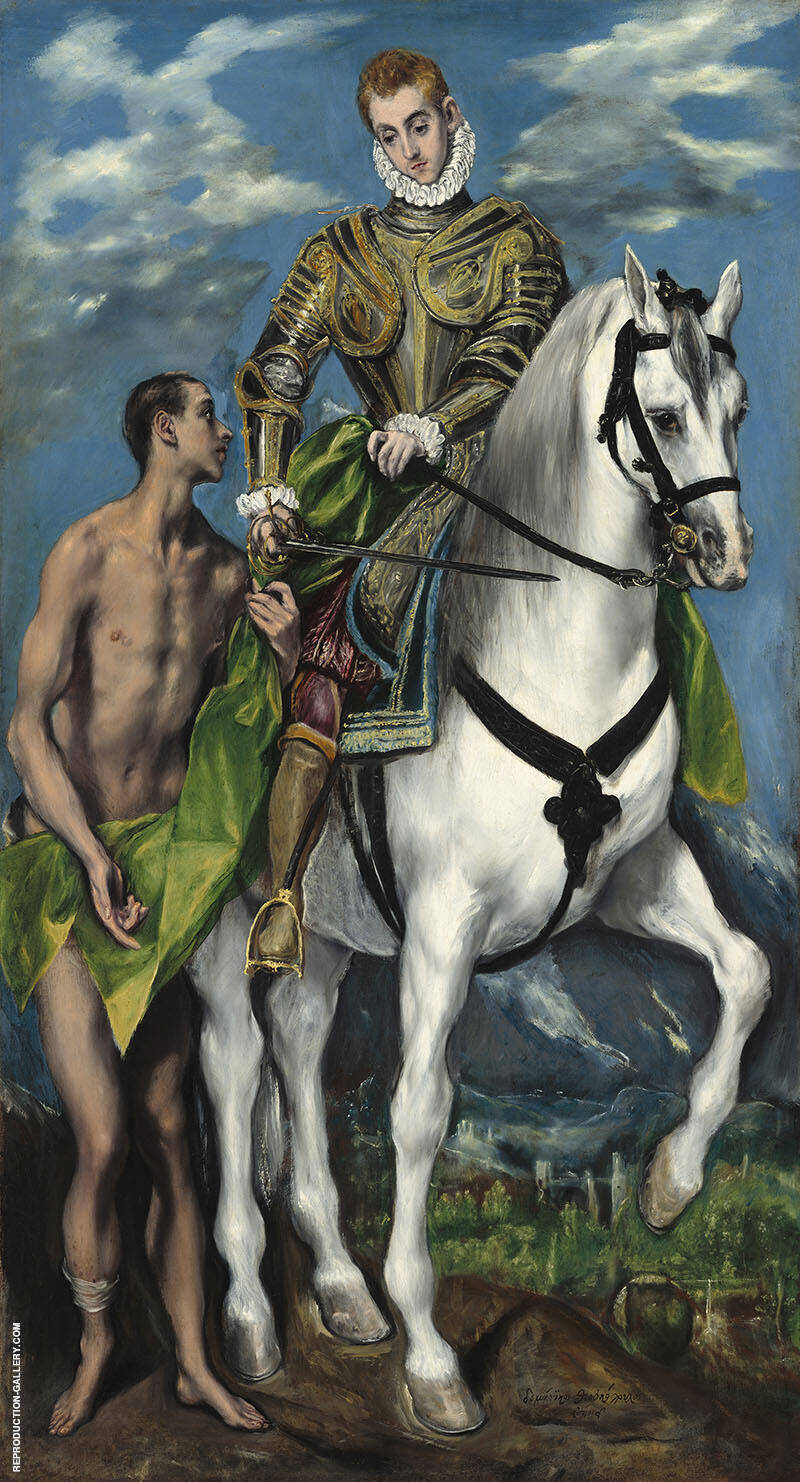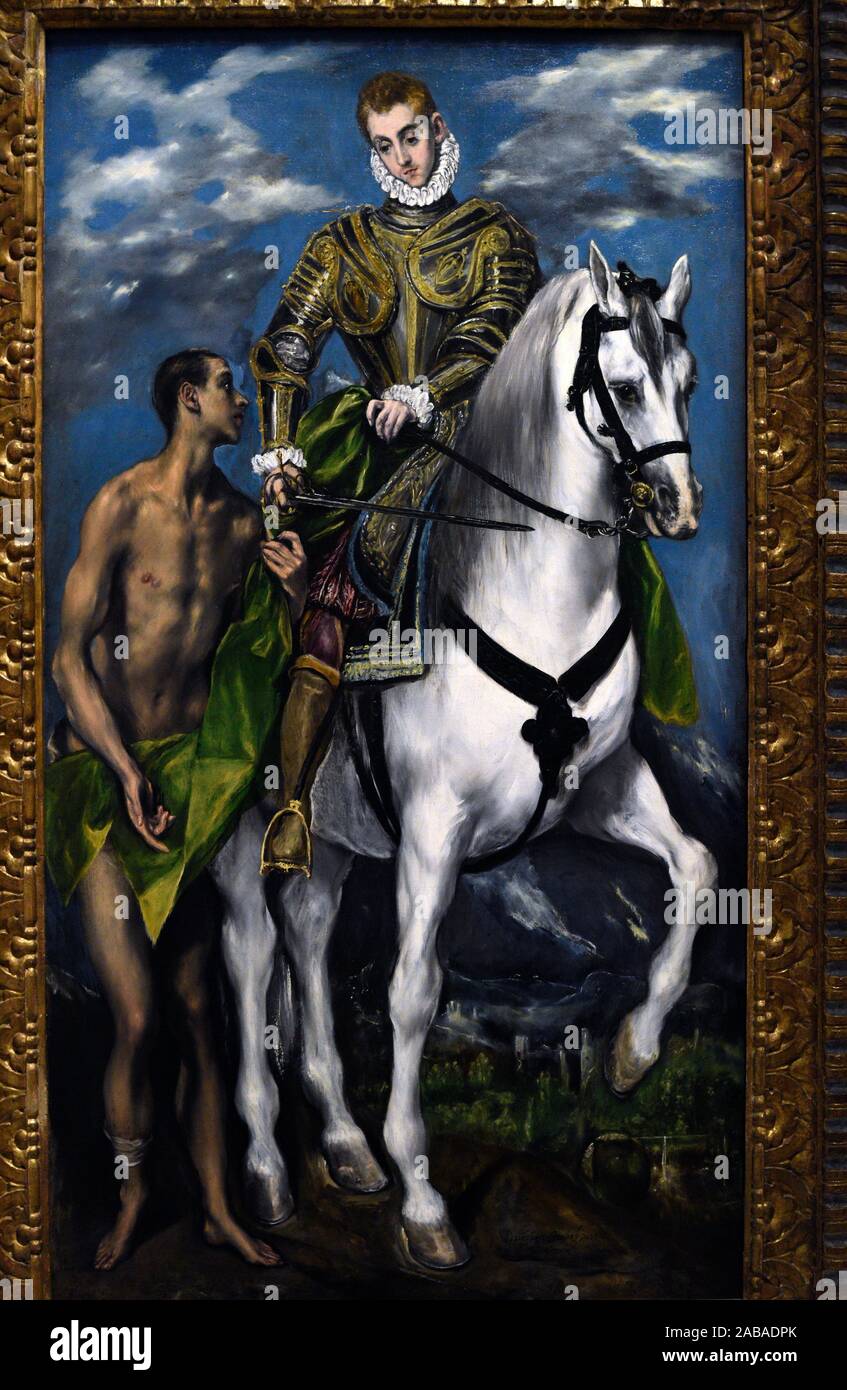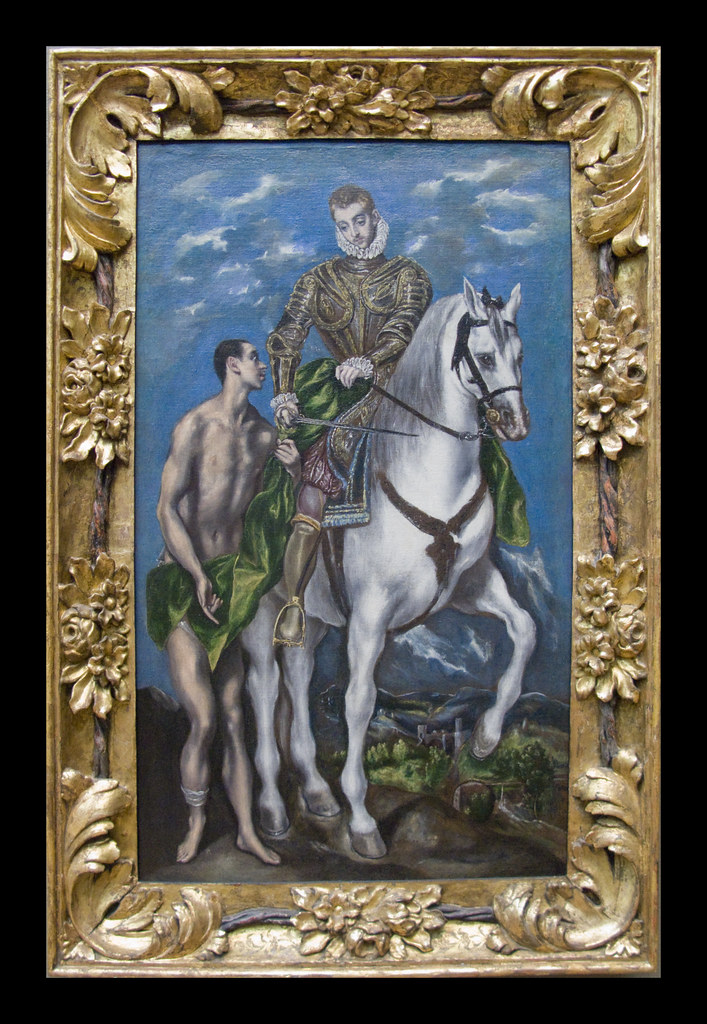
Saint Martin and the Beggar c1599 by El Greco Oil Painting Reproduction
Saint Martin and the Beggar by El Greco. St. Martin's popularity in France can also be attributed to his adoption by successive royal houses of France. Martin was most generally portrayed on horseback, dividing his cloak with the beggar. From the 4th century to the late Middle Ages, much of Western Europe engaged in a period of fasting.

Domenico El Greco Der heilige Martin Poster Kunstdruck bei Germanposters.de
St Martin and the Beggar 1597-99 Oil on canvas, 193 x 103 cm. Clad in gold damascened armour with a ruff typical of fashionable Toledan dress in El Greco's day, St Martin is shown astride a white horse as he prepares to cut his bright green cloak in half in order to share it with the beggar who stands on the left. Below, a distant and freely.

SachsenLese Martinsgans und Martinstag
El Greco, "Saint Martin and the Beggar," 1597-1599. [ Source .] Here, the sixteenth century Spanish painter El Greco depicts the story of St. Martin and the beggar. It is the dead of winter, and bitterly cold. Martin, a soldier in Rome's imperial army, comes across this poor, naked man at the city gates of Amiens in Gaul.

Καθολικός διάκονος St Martin of Tours "a man words cannot describe"
El Greco, St. Martin and the Beggar, 1597-1600; Van Dyck, St Martin Dividing his Cloak, 1618; His November 11th feast day (Martinmas Day) was a big deal in the Middle Ages. It served a purpose similar to our Thanksgiving as the great Fall feast, coming at the time of the harvest, the slaughtering of animals (cattle and pigs), and enjoying the.

Artwork by El Greco List El Greco Paintings & Sculptures (Page 2)
El Greco, a prominent artist of the Spanish Renaissance, painted this work around 1597-1599. The dramatic scene is portrayed in Mannerism style, with elongated figures and exaggerated poses. El Greco depicts Saint Martin wearing contemporary armor with intricate gold inlay, adding a modern twist to the traditional story.

10 Paintings and Artworks By El Greco You Should Know
El Greco's Saint Martin and the Beggar was painted between 1597 and 1599. It was originally made for the Capilla de San José, a chapel in Toledo. It is part of the National Gallery of Art's collection in Washington, DC. The original oil painting measures 193.5 by 103 centimetres, or 76.2 by 40.6 inches. A smaller version of the painting at.

El Greco's Saint Martin and the Beggar, circa 1600 Postcard Zazzle
[1] Harold E. Wethey, El Greco and his School 2 (Princeton, 1962): 247, no. X-401, identifies the NGA Saint Martin and the Beggar as the one sold as part of the Baron Taylor collection. The only information provided in the sale catalogue for lot 22 is the title and artist (El Greco). It is therefore impossible to identify which of the five small versions of St. Martin and the Beggar was sold.

"St Martin Dividing His Cloak with the Beggar" by Manuel Theotokopoulos (son of El Greco
Griswold, Susanna P. "Two Paintings by El Greco: Saint Martin and the Beggar." Studies in the History of Art 41 (1993): 133, 140-148, repro. no. 1. 1997 Tomlinson, Janis.. 4th St and Constitution Ave NW Enter and exit from 4th Street. Sculpture Garden 7th St and Constitution Ave NW Enter and exit from 7th Street, Constitution Avenue, or.

Saint Martin and the Beggar, painting by El Greco, 18971599, Washington, National Gallery of
El Greco, Saint Martin and the Beggar, 1597-1600 Art Institute of Chicago El Greco, View of Toledo , 1599-1600 Metropolitan Museum of Art

St. Martin and the Beggar, El Greco, 159799 El greco paintings, National gallery of art
The painting was originally placed opposite another of El Greco's paintings, Saint Martin and the Beggar, in the Chapel of Saint Joseph in Toledo and represents a body of work made between 1957 and 1607 of various commissions characterizing his mature period. This work is an example of his deeply expressive nature and stylized approach to form.

El greco, martin Fotos und Bildmaterial in hoher Auflösung Alamy
Saint Martin and the Beggar is a painting by the Greek mannerist painter El Greco, painted c. 1597-1599, that currently is in the collection of The National Gallery of Art, Washington, DC. It depicts a legend in the life of Christian saint Martin of Tours: the saint cut off half his cloak and gave it to a beggar.. El Greco made a smaller version of the painting that is in the collection of.

SZENT MÁRTON és a szent liba receptje Food & Wine
Saint Martin and the Beggar. about 1597-about 1600. El Greco (Doménikos Theotokópoulos) Greek, active in Spain, 1541-1614. This painting is a small replica of an altarpiece for the private family chapel of San José in Toledo, Spain. The production of smaller versions of commissioned altarpieces allowed El Greco to introduce his creations.

Popular Spanish Renaissance Paintings Famous Paintings from the Spanish Renaissance Movement
The Entombment of Christ, c.1570. St. Martin and the Beggar, 1597-1599. Complete Works. St. Martin and the Beggar is a painting by the Greek-born, Spanish artist El Greco. It is part of the Widener Collection and is currently held in the National Gallery of Art in Washington. The painting is done in oil on canvas and measures 42 5/16 by 22 7/8.

Sankt Martin Der Geschichte vom Typ mit dem halben Mantel
See full Interactive video on Saint Martin and the Beggar by El Greco at the National Gallery of Art West Building https://nlcultural.com/saint-martin-and-th.

El Greco St Martin. Martin Beek Flickr
El Greco paintings of St. John the Baptist and St. John the Evangelist 9. Santo Domingo el Antiguo. This church has three paintings by El Greco — The Resurrection, St. John the Baptist, and St. John the Evangelist. St. John is shown in his customary attire. He's depicted as a bearded man dressed in simple garments made of animal skins His.

El Greco's "St Martin and the Beggar" one of seven El Grec… Flickr
El Greco. Saint Martin and the Beggar is a painting by the Greek mannerist painter El Greco, painted c. 1597-1599, that currently is in the collection of The National Gallery of Art, Washington, DC. It depicts a legend in the life of Christian saint Martin of Tours: the saint cut off half his cloak and gave it to a beggar.